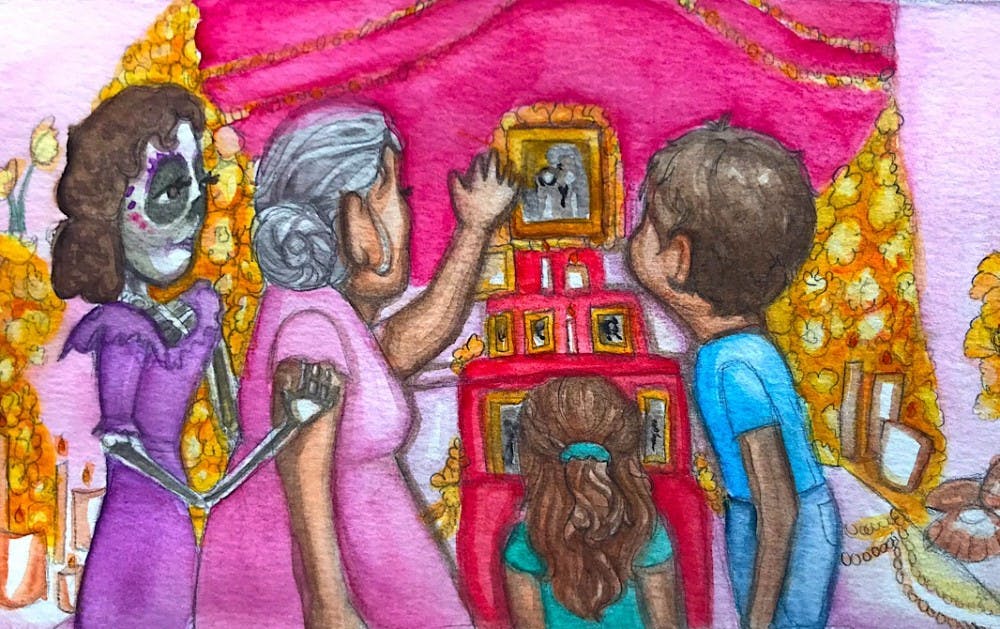Dia de los Muertos, or the Day of the Dead, is often known for its colorful decorations and sugar skull designs, but there is much more behind the traditional Mexican holiday.
A group of ASU alumni created an educational website about Dia de los Muertos in an effort to educate the public about the holiday and encourage them to celebrate without appropriating Hispanic culture.
Caleb Barclay, Kelly Barclay and Ben Adam met at ASU and launched the site this year after researching Dia de los Muertos and interviewing both Mexican and American citizens whose families celebrate the holiday.
Dia de los Muertos is a 2-day holiday celebrating the lives of those who have died. It starts at midnight Oct. 31 and ends Nov. 2. The holiday is believed to be a time when the dead can visit the physical world and temporarily reunite with the living.
Unlike Halloween, Dia de los Muertos is a time of celebration rather than horror or mischief. Though it deals primarily with death it is not a holiday of grief, and families instead express love and joy, pass down memories and gather at the graves of loved ones.
Caleb Barclay, who graduated in 2009 with a degree in architecture, said much of the website design centered around capturing that joy in a way that previous sites dedicated to the holiday hadn’t.
He said he and his wife Kelly Barclay were inspired to create the site after watching the Disney movie “Coco” and realizing that while the film inspires Americans to research the holiday, many stopped their research at the surface-level.
“One of the motivators was that people are looking to Wikipedia primarily to understand the holiday,” he said. “But there's not the feeling and the colors and the imagery that really makes it special.”
The site features content ranging from information detailing the customs of the holiday to printable coloring pages which the group encourages people to color in and share with them on Instagram.
The site also includes free downloadable moving illustrations designed by Caleb Barclay, information about local Dia de los Muertos celebrations and an active countdown to the holiday on its front page.
Caleb Barclay said that even with all the work the group put into the site, it can never be all-inclusive of Dia de los Muertos traditions.
“There’s edits — content that makes it, and there's content that doesn't,” he said. “So there is some bias or some vantage point that we're presenting the stories (from).”
He said the greatest lesson he found while creating the website was the deeply harmful nature of cultural appropriation, even when done with good intentions.
“When you're taking your favorite parts about a culture and leaving out potentially the most important aspects — like for example, if you're taking the skeleton imagery, dressing up, having fun and never really understanding the significance of the holiday … when you leave those out, it's disrespecting the non-dominant culture.”
Adam, who graduated in 2010 with a degree in sustainability, was the site’s developer and said the group wanted to create a unique design that pushes limits to create something memorable.
“A huge priority for us was to make something that was authentic. There's an aspect of story to it, there's a lot of history, there's a lot of information that is really interesting and relevant to people," he said. "Just bringing that to life and showcasing that in a unique way was something that was definitely different.”
Kelly Barclay, who graduated in 2011 with a degree in social work, said building the site took on a more personal significance for her as someone with Mexican heritage.
“I think that’s what encouraged me to want to be a part of the project even more,” she said. “I think it’s important to have a voice and especially to educate, in a way, different sects of American culture.”
Adam said working on the site emphasized for him the power that can come from learning about other cultures as someone not of Mexican decent.
“If you take the time to listen, and if you take the time to understand, then you can enter into that with people and enjoy it with them in a way that's not appropriating it or trying to make it your own," he said. "Just participating and understanding somebody else in a deeper way is really special.”
Reach the reporter at mrobbin9@asu.edu or follow @MelissaARobbins on Twitter.
Like The State Press on Facebook and follow @statepress on Twitter.




